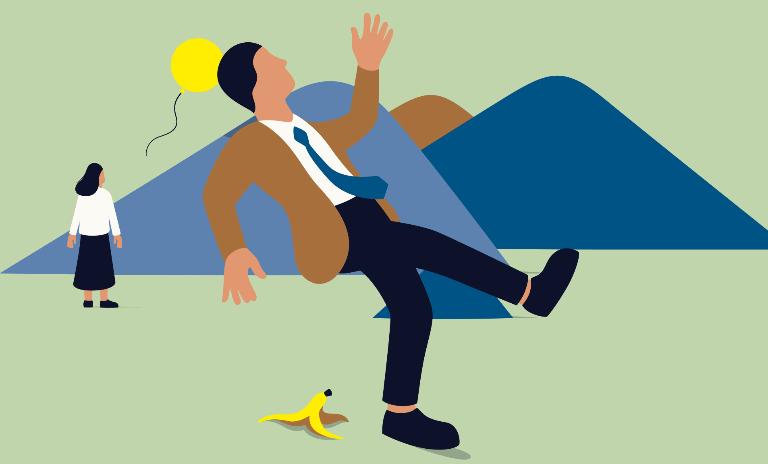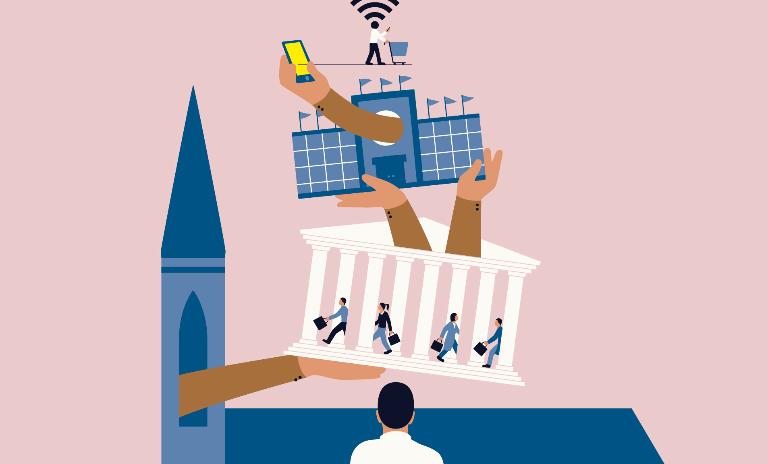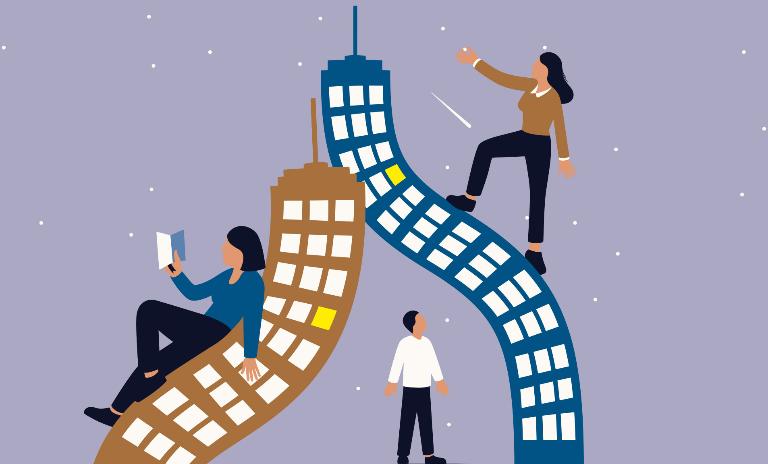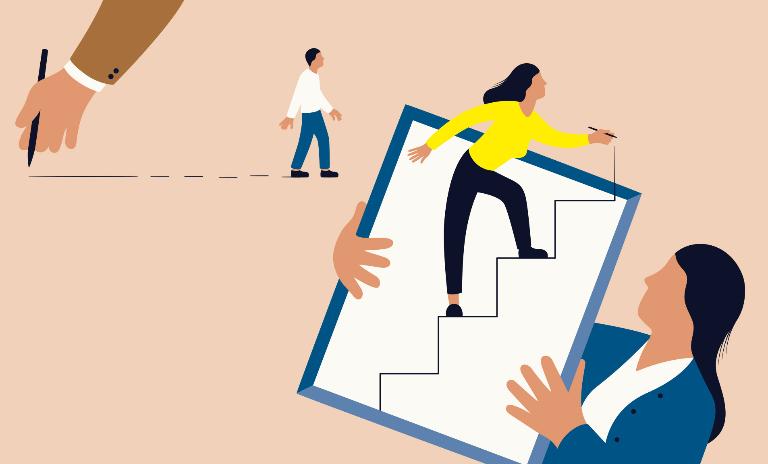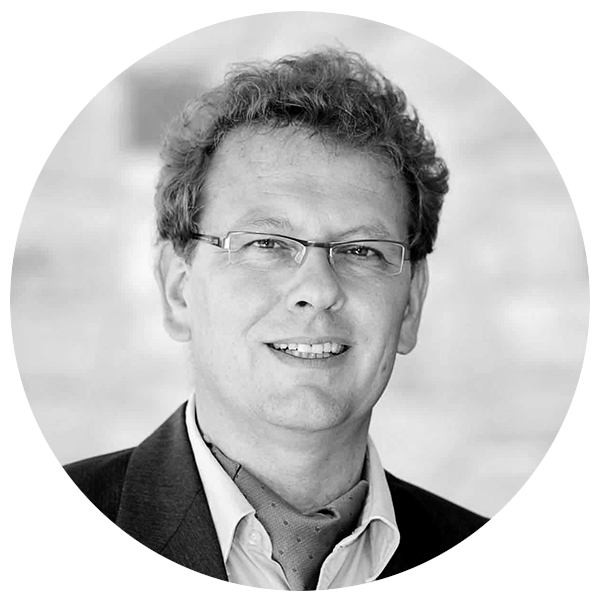Your path to tomorrow, today
![{[downloads[language].preview]}](https://www.rolandberger.com/publications/publication_image/tam_future_cover_en_download_preview.jpg)
The actions of the present lay the foundations for the future. What does this saying mean in turbulent times? Consider a mix of solidity and flexibility!


by Detlef Gürtler
Artwork by Francesco Ciccolella
The present – with all its complexities and problems – might seem to require all your attention, but you need to keep your eye on the horizon too. So how can you shore yourself up against the coming storms without losing sight of what is right in front of you today?
"Neither an ox nor a donkey is able to stop the progress of socialism." When Erich Honecker, the leader of communist East Germany, made that bold statement in August 1989, he didn't know that just two months later he would be ousted from power. Or that a year later, in 1990, the entire country would cease to exist – let alone that the whole Communist Bloc, one of the most impressive power structures the world has ever seen, would disappear by 1991. Formed by the Soviet Union in the aftermath of World War II in Eastern Europe, the Bloc seemed like it was built to last: a number of heavily armed countries, all with a close to absolute domination over all sectors of the economy and the public (and even private) lives of those who lived in them. Then it all came crashing down, like a comedian slipping on a banana peel. And funnily enough, it was Communism's failure to provide its citizens with simple stuff of daily life – nylons, faucets and, yes, bananas – that was a key factor in its collapse at the end of the 20th century.
The promise of a better life tomorrow is a bad excuse for a lousy performance today. The same can be true for the opposite strategy: Being able to deliver short term can become disastrous if your long-term perspective is a mess. Two mid-sized German banks, IKB and Sachsen LB, learned that lesson in July 2007. Over the years, they had made steady and decent profits with investments in US mortgage-backed securities – until the music stopped with the global financial crisis. Within a weekend they transformed from being solid, somewhat boring banks into a financial avalanche that threatened to drag the whole German financial system into the abyss.
The promise of a better life tomorrow is a bad excuse for lousy performance today.
There is a void at both ends of the playing field: Short-termism can pay off nicely, until it doesn't; and long-termism may pay off in the end, but – how to put this politely? – in the end, we're all dead. "Both sides exist – so deal with it," recommends Charles O'Reilly, professor of management at the Stanford Graduate School of Business and co-author of "The Ambidextrous Organization". Settling somewhere in between "future-only" and "present-only" strategies may sound like a golden mean, but it can quite easily turn into a middle ground of mediocrity. For O'Reilly, "the essence is to be both: a good short-term manager and a good long-term manager." He calls this being ambidextrous. But even if you can manage companies with both hands as well as Cristiano Ronaldo can score goals with both feet, the two sides are still different things. You have to "host multiple contradictory structures, processes and cultures," admits O'Reilly.
There is a tension between exploiting the present and exploring the future, between building long-lasting structures and implementing an operative system that can be "fluid" and innovative. It's a necessary tension, like building a cathedral that is designed not only to be used for worship on Sundays, but also to serve as a trading bazaar each morning. One industry where that tension can be observed throughout history is in the bazaar industry itself: retail. The bazaar, or the market, was the default global shopping system throughout history. The Greek "agora," the Roman "forum" or the Arabic "medina" were all hemmed in by impressive administrative and religious buildings – and then filled with any number of trading booths and small workshops.
It wasn't until the middle of the 19th century that the first retail cathedrals were built. Department stores like Au Bon Marché in Paris, Harrods in London or Macy's in New York became shopping temples, bringing goods from all over the world to the metropolitan upper class. The department stores shaped the image of shopping in the industrial age – and the model seemed unbeatable. Until the second half of the 20th century, that is, when a more adaptive structure emerged: the shopping mall. They were impressive buildings, and they brought the bazaar into the cathedral. A lot of small shops could come and go under the mall's roof, and that system outgunned the now cumbersome-looking department store dinosaurs. "The higher flexibility was a competitive advantage for the shopping mall," says Karin Frick, head of Think Tank, Gottlieb Duttweiler Institute, "but now the mall seems to be succumbing to an even more flexible competitor – the internet." The more customers get used to shopping wherever, whenever and for whatever they want, the less they need the brick and mortar malls that stipulate both the times and the place in which that shopping can occur. The "cathedrals" have become virtual.
The next step is already on the way: a business model that combines the cathedral with the bazaar.
In online retail, we're about to see this go full circle yet again. E-commerce took off in an almost anarchic fashion during the dotcom boom with any number of shops and tools and apps – a bit like the bazaar. Then the first cathedral emerged: Amazon. The online giant offers everything for everyone, just like Macy's, Harrods or Karstadt had started doing offline more than a century before. Amazon is less glossy than its predecessors – its solid structures are automated warehouses – but it is even more powerful. Amazon has become one of the world's most valuable companies and, once again, it is seemingly unbeatable.
If history repeats itself, then the next step is already on the way: a business model that combines the cathedral with the bazaar. And indeed, it's already here – Alibaba. The Chinese retail giant owns even less real-world assets such as warehouses or robots because it itself is not the seller of all the things people buy via its platform. It is, instead, just that: a huge and trustworthy platform for buyers from everywhere to connect with sellers of everything. Though still much smaller than Amazon, and with roughly a quarter of the revenue, Alibaba has sustained higher margins than its US-based counterpart for years. The more flexible approach with fewer fixed costs should give Alibaba a competitive edge, especially in the development of new markets and regions.
Those switches from bazaar to cathedral, to bazaar within real cathedral, to virtual cathedral within real bazaar, are always made by a new kid on the block. Incumbents seem to struggle to master the challenges and often vanish with their business model. "You have to decide whether you shall take away capabilities from known businesses to new businesses with lower margins, but higher long-term potential," O'Reilly says. And the decision often leads to short-term gain and long-term pain: "Companies like Blockbuster or Barnes & Noble saw what was coming, but they were not able to get into the new business lines." But Richard Kelly is convinced that traditional businesses can adapt to the speed and scope of technological change and market disruption. Kelly is the chief catalyst of the Hong Kong-based Fung Group. The trading conglomerate, founded as Li & Fung 113 years ago, employs more than 20,000 people worldwide and is best known as the supply chain manager for western brands and retailers. "My job is to reignite t he cultural innovation across the organization ," Kelly says, and he does it by "making really loud noises at the edge of the business and learning from it as fast as we can."
Combining solidity and flexibility may sound a bit weird, but it is the obvious choice.
One of the main instruments with which Kelly makes those noises is located near Shanghai and is called the "Exploratorium" – a kind of shopping mall for business clients. At the Exploratorium, Fung, its suppliers and its buyers can experiment with new sales approaches and business models while at the same time getting information about new ways of doing business that others are testing. For Kelly, doing lots of experiments and looking at even more of them is the best way to future-proof your company: "Even if you have been around for 100 years, you should know that the best way to optimize your old business model is to search for and experiment with new ones." Combining solidity and flexibility may sound a bit weird, but it is the obvious choice for those situations where hard and heavy impacts could strike any time. Building skyscrapers in earthquake-prone regions is one of those situations, and building large-scale enterprises in disruption-prone industries is another. And in the digital era, well, every industry is disruption-prone.
To apply the retail industry experience to organizational challenges, ask the following questions: Can you build a company like a shopping mall? Can you fill the cathedral (a big and solid external structure) with a bazaar (a multitude of approaches for maximized internal flexibility)? This hasn't been a very common organizational model to date, and that's to put it mildly. Karin Frick points out that size still matters – in a negative way. "Large-scale companies have an innate problem with too much bureaucracy and too little creativity. You can't simply decree that you keep the size, but skip the bureaucrats." The second-best option is to keep the flexibility, but at arm's length. "That's the way big pharma does it," explains Frick. Pharmaceutical giants like Novartis, Merck and GlaxoSmithKline need a large and well-oiled machine to turn new drugs into global blockbusters, so they developed a strong corporate culture of reliability. But drug research and development requires a culture of flexibility and creativity – and that's quite the opposite. The solution? "They leave a growing part of drug development and early-stage tests to small companies. It's easier to acquire the small ones, once proven successful, than to foster two opposite corporate cultures in one company."
This frame-plus-flexibility design can be found not just at the society level, but in business too.
The only major company that has combined solidity and flexibility rather successfully under one roof is Google. The search engine and its algorithms form one of the most impressive structures of the digital world. But from the very beginning, Google has encouraged its employees to do more than simply improve on the search cathedral – and in particular to do something completely different. Or better. And not something: anything. The markets Google operates in change in huge and rapid and unforeseeable moves, and the people Google employs are so savvy, quick and independent that the best strategy to stay ahead of the competition is to trust their own people to do what's right – or at least fail trying. Jeff Jarvis, professor for journalism at City University New York and author of "What Would Google Do?", explains it biologically: "It's so much in their DNA to see things differently" – in the DNA of the company and in the DNA of the people working there.
The 80:20 rule was a symbol for this deeply ingrained approach. Employees were encouraged to spend up to 20% of their time on projects that they themselves felt to be important. Shielded by the strength of the core product, search, Google's software engineers developed an abundance of ideas, projects and products like no other company on earth. The concept was effectively a victim of its own success and Google has quietly abolished the rule – because the results were too good. Lots and lots of promising products just couldn't get the resources for further development, because there were simply too many promising products around. But that's a different story, and it's a problem that every other company would love to have.
We started this story with German politics and its relatively recent and blatant example of failure. And German politics is a good place to end it, too – but this time, with a success story. Think about this: The recipe that made Google great in the first decades of the 21st century is very similar to the one that made the (West) German economy great in the second half of the 20th century. The Germans even coined a term that combines the solid external shield with the flexible interior design: soziale Marktwirtschaft, or the social market economy. It offers a trustworthy framework with the rule of law, political stability and social security for everybody, and within this framework it allows the maximum freedom for individuals and companies. Being freed from short-term hassle means being free for all-term performance.
This frame-plus-flexibility design can be found not just at the society level, but in business too. Take, for example, working hours in Germany. With the so-called "short time” or "reduced hours” instruments, the employee can work less and the employer can pay less, but the state takes up the slack and jumps in to pay part of the shortfall. This gives huge flexibility especially during an economic downturn. People don’t lose their jobs, companies don’t go bust and that’s a win-win. Combine that with flexible working agreements (such as unpaid overtime when necessary, but paid time off when there is no work) and you have a very flexible tool – as shown during the financial crisis, when German manufacturing nosedived. Interventions such as these can build stronger relationships between workforce and management. After all, the less you have to talk about money (which, let’s face it, is always a conflict) the more you can think about new ideas. And who wouldn’t want that?
After printing the magazine, the text was updated for the online edition.
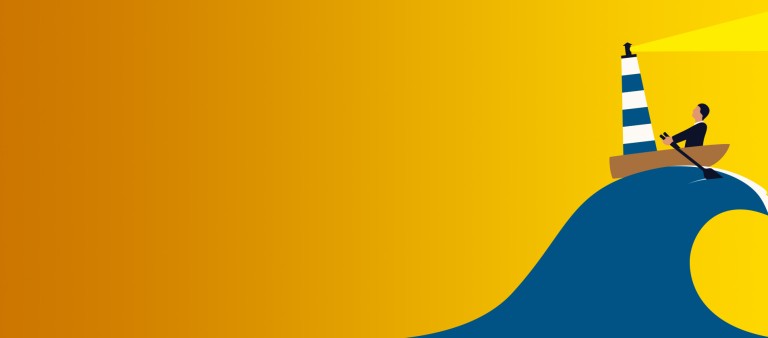
![{[downloads[language].preview]}](https://www.rolandberger.com/publications/publication_image/tam_future_cover_en_download_preview.jpg)
The actions of the present lay the foundations for the future. What does this saying mean in turbulent times? Consider a mix of solidity and flexibility!
Curious about the contents of our newest Think:Act magazine? Receive your very own copy by signing up now! Subscribe here to receive our Think:Act magazine and the latest news from Roland Berger.

